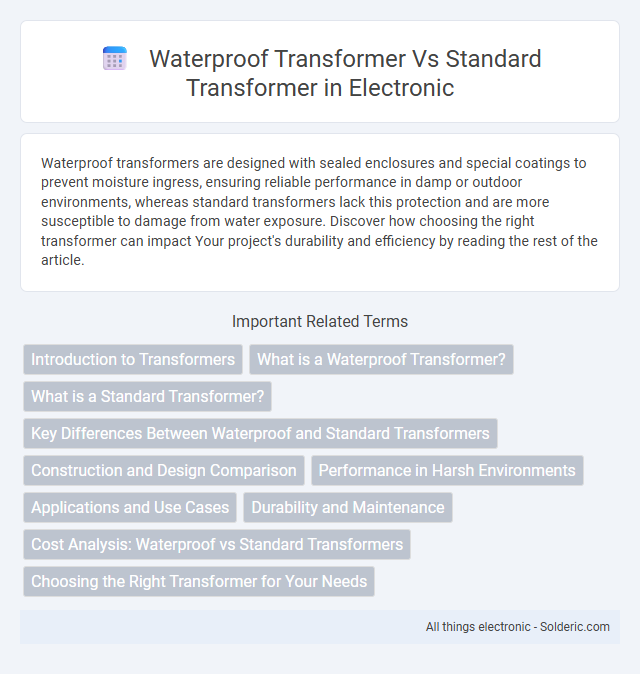Waterproof transformers are designed with sealed enclosures and special coatings to prevent moisture ingress, ensuring reliable performance in damp or outdoor environments, whereas standard transformers lack this protection and are more susceptible to damage from water exposure. Discover how choosing the right transformer can impact Your project's durability and efficiency by reading the rest of the article.
Comparison Table
| Feature | Waterproof Transformer | Standard Transformer |
|---|---|---|
| Protection | Waterproof enclosure, IP65 or higher rating | No special water protection, typically IP20 to IP44 |
| Application | Outdoor, wet, or humid environments | Indoor, dry environments |
| Durability | Resistant to moisture, corrosion, and dust | Standard durability with limited moisture resistance |
| Cooling | Sealed cooling system for waterproofing | Open or ventilated cooling system |
| Cost | Higher due to specialized sealing and materials | Lower cost, standard materials used |
| Maintenance | Lower maintenance in harsh conditions | Requires protection and maintenance in moist environments |
| Weight | Slightly heavier due to additional sealing | Lighter, no extra sealing materials |
Introduction to Transformers
Transformers are electrical devices that transfer electrical energy between circuits through electromagnetic induction, with waterproof transformers specifically designed to operate safely in wet or outdoor environments by using sealed enclosures and moisture-resistant materials. Standard transformers, by contrast, are suitable for indoor or dry settings where exposure to moisture is minimal. Choosing the right transformer depends on your application's environmental conditions and protection requirements.
What is a Waterproof Transformer?
A waterproof transformer is designed with protective enclosures and sealing materials that prevent water ingress, ensuring safe and reliable operation in wet or outdoor environments. Unlike standard transformers, waterproof transformers can withstand exposure to rain, humidity, and splashes without electrical failure or corrosion. Your choice of a waterproof transformer ensures durability and consistent performance in challenging conditions where moisture is present.
What is a Standard Transformer?
A standard transformer is an electrical device designed to transfer electrical energy between two or more circuits through electromagnetic induction, typically used in indoor or controlled environments. It features insulation materials and enclosures that provide basic protection against dust and moisture but are not designed to withstand direct water exposure or harsh outdoor conditions. Standard transformers are commonly utilized in residential, commercial, and industrial applications where environmental exposure is limited and controlled.
Key Differences Between Waterproof and Standard Transformers
Waterproof transformers are designed with sealed enclosures and corrosion-resistant materials to withstand exposure to moisture, making them ideal for outdoor and wet environments. Standard transformers typically lack these protective features, which limits their use to dry, indoor settings where water damage is minimal. Choosing a waterproof transformer ensures your electrical system remains reliable and safe under harsh weather conditions.
Construction and Design Comparison
Waterproof transformers feature sealed enclosures with robust insulation materials such as epoxy resin or silicone, designed to prevent water ingress and withstand harsh environmental conditions. Standard transformers typically have open or vented designs with less protective casing, making them more susceptible to moisture and dust exposure. The enhanced sealing and rugged construction of waterproof transformers ensure reliable performance in outdoor or wet locations, contrasting sharply with the basic design of standard transformers suited for dry, controlled environments.
Performance in Harsh Environments
Waterproof transformers are engineered with sealed enclosures and corrosion-resistant materials, ensuring reliable operation in harsh environments characterized by moisture, dust, and extreme temperatures. Standard transformers, lacking such protective features, are prone to degradation, insulation failure, and electrical faults when exposed to adverse conditions. The enhanced durability of waterproof transformers significantly reduces maintenance costs and downtime in industrial, outdoor, and marine applications.
Applications and Use Cases
Waterproof transformers are essential in outdoor and harsh environment applications such as street lighting, marine equipment, and industrial machinery exposed to moisture, ensuring reliable operation despite water ingress. Standard transformers are typically used in indoor settings like residential, commercial, and office buildings where environmental conditions are controlled and protected from water exposure. Selecting the appropriate transformer depends on the operational environment to maintain safety, efficiency, and longevity in electrical power distribution.
Durability and Maintenance
Waterproof transformers feature sealed enclosures and corrosion-resistant materials that enhance durability by preventing moisture ingress and electrical faults, significantly reducing the risk of short circuits and equipment failure. Standard transformers, lacking such protection, often require more frequent maintenance to address issues caused by exposure to humidity and contaminants. This protective design in waterproof transformers leads to extended service life and lower overall maintenance costs compared to standard transformers.
Cost Analysis: Waterproof vs Standard Transformers
Waterproof transformers generally have a higher upfront cost compared to standard transformers due to enhanced sealing materials and protective coatings designed to prevent moisture ingress. Your investment in waterproof transformers can lead to reduced maintenance expenses and longer service life in harsh environments, offsetting the initial price difference over time. Standard transformers, while cheaper initially, may incur higher repair and replacement costs if exposed to moisture or outdoor conditions without adequate protection.
Choosing the Right Transformer for Your Needs
Waterproof transformers are designed with sealed enclosures and corrosion-resistant materials to withstand harsh environmental conditions, making them ideal for outdoor or wet locations. Standard transformers, while effective in controlled indoor environments, lack the protective features necessary to prevent moisture ingress and potential electrical failures. Evaluating your specific application and exposure risks ensures you select the right transformer that guarantees safety, reliability, and longevity for Your electrical system.
waterproof transformer vs standard transformer Infographic

 solderic.com
solderic.com